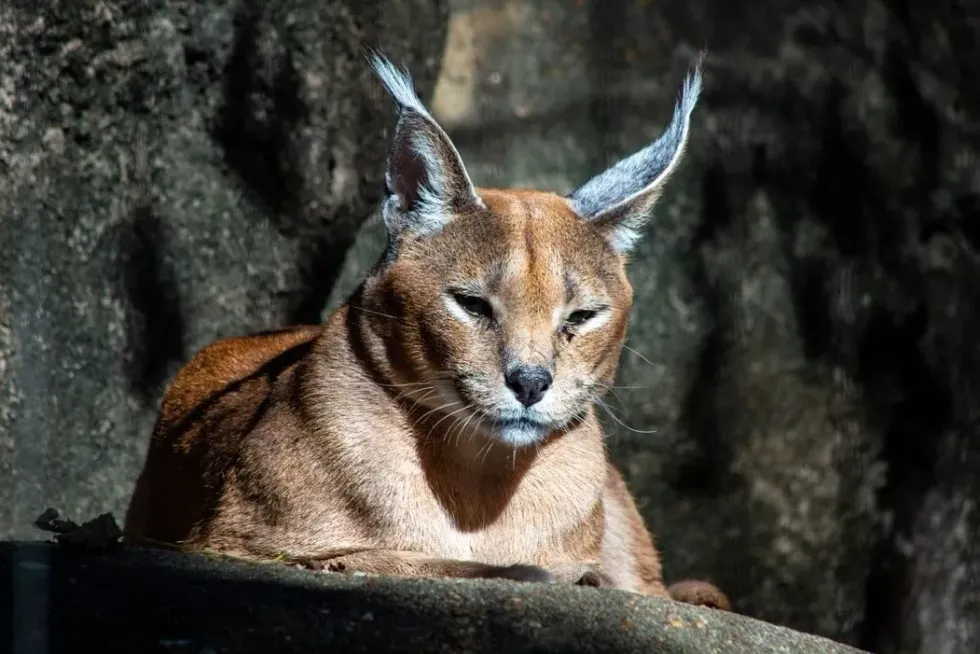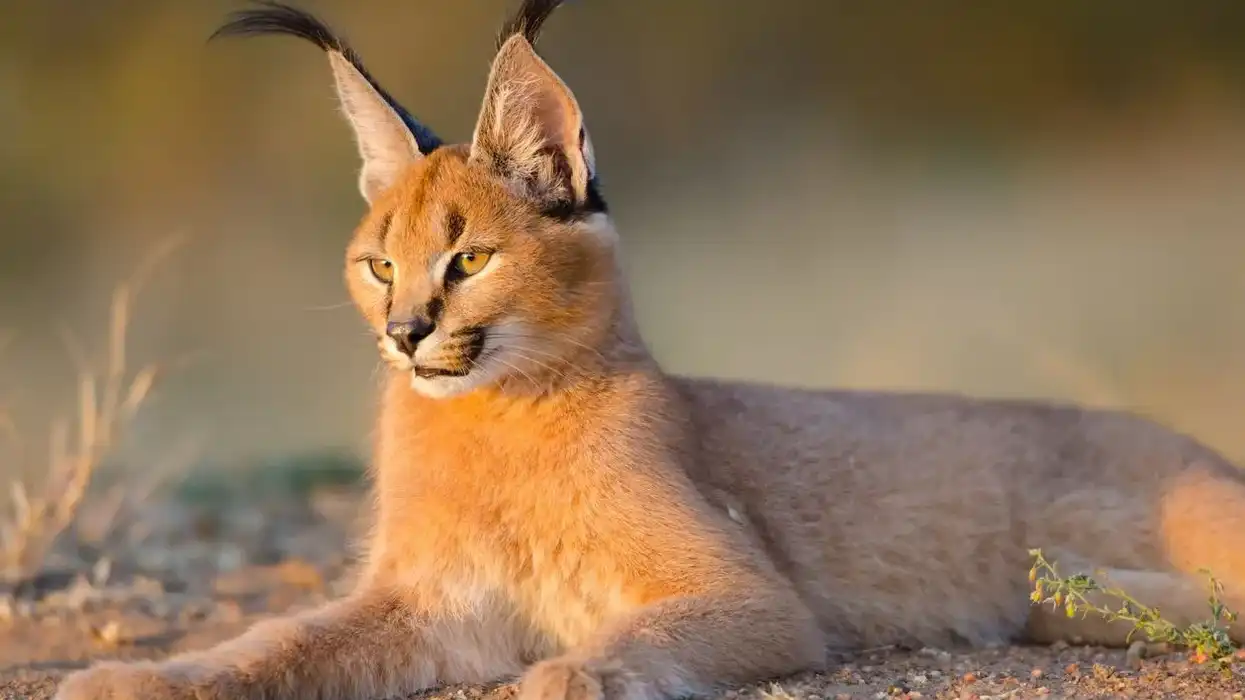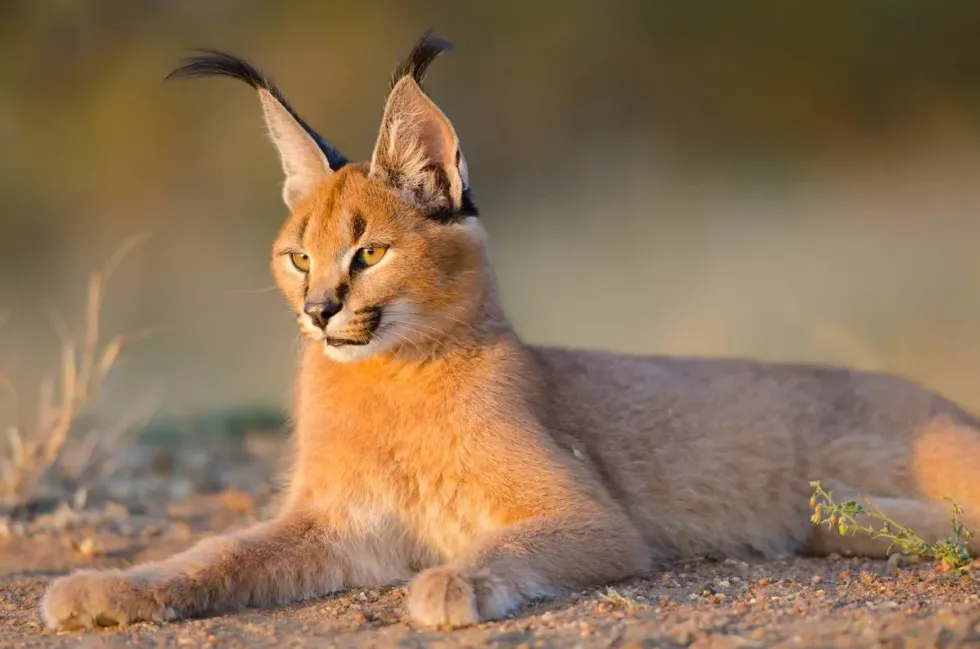Fun Caracal Facts For Kids
Content
- What type of animal is a Caracal?
- What class of animal does a Caracal belong to?
- How many Caracals are there in the world?
- Where does a Caracal live?
- What is a Caracal's habitat?
- Who do Caracals live with?
- How long does a Caracal live?
- How do they reproduce?
- What is their conservation status?
- What do Caracals look like?
- How cute are they?
- How do they communicate?
- How big is a Caracal?
- How fast can a Caracal move?
- How much does a Caracal weigh?
- What are their male and female names of the species?
- What would you call a baby Caracal?
- What do they eat?
- Are they dangerous?
- Would they make a good pet?
- Did you know...
- What are Caracals known for?
- Do people keep Caracals as pets?
The Caracal is a wild cat belonging to the class Mammalia (mammal) that is native to parts of the Middle East, India, and Central Asia, and Africa. It is a medium-sized cat that is characterized by its short face, strong build, and long black tufted ears, with long legs.
They have a reddish or sand-colored fur that helps in camouflaging them in the wild when it hunts for prey. They are opportunistic hunters and hunt whatever they find, from small animals like mongoose to large animals like deers.
They communicate with other caracals via twitches and other movements; their strong hind legs allow them to leap high and catch birds in flight.
They are secretive and nocturnal, which makes them tough to observe. They are solitary animals who mark their territories and will get aggressive towards trespassing animals.
Caracals have played a great part in history as Chinese emperors gave caracals as gifts. Up until the 20th century, caracals were used by rulers in India to hunt small game.
Caracals seem to have religious importance in ancient Egypt as they occur as bronze figurines which are thought to have been guards of the tombs of pharaohs. For more Caracal cat facts and its prey drive, read on!
If you like these facts about the Caracals, then you'll surely like these facts about ocelot and Egyptian mau too.
Caracal Interesting Facts
What type of animal is a Caracal?
The Caracal (pronounced ker-a-kal) is a medium-sized wild cat. It is robustly built, with long legs, a short face, black ear, and long black tufts. They have a sleek, streamlined body, with a reddish-gold coat and markings on their faces and strong hind legs that help them in jumping high enough to catch birds out of the sky.
What class of animal does a Caracal belong to?
Caracals are mammals. This means these wild cats have three middle ear bones, fur or hair, and the females have mammary glands which are used to feed their young ones.
How many Caracals are there in the world?
The actual number of Caracals in the wild is unknown for the time being. In Asia and North African parts, they are considered rare, threatened, and endangered species. In southern and central Africa, they are considered to be present in a widespread number.
Where does a Caracal live?
Caracals are desert dwellers and live on rocky hills and, in some exceptions, on the grasslands in the Middle East, Africa, and South Asia. Caracals are also known as desert lynx and are one of the more than 30 species of small wild cats.
What is a Caracal's habitat?
Caracals live in a diverse habitat. They can be found in woodlands, scrub forests, plains, rocky hills, and thickets. They prefer edge habitats, like a transition of a forest/grassland.
Caracals can be found at elevations over 3000 meters in the Ethiopian mountains of Ethiopia in Africa. They prefer an arid climate with minimal foliage. In the Asian regions, they are found in forests and seldom live in tropical or desert environments.
Who do Caracals live with?
Caracals are solitary wild cats, living alone or in pairs. Caracals, mostly adults, prefer to spend most of their days hunting. Mothers with their offspring are the only group that can be found naturally. Their social system, however, is not well understood as these cats appear to defend territories that they mark with urine.
How long does a Caracal live?
In the wild, these cats have a lifespan of 10-12 years. Whereas in captivity, with a good diet and care, they can live for as long as 20 years.
How do they reproduce?
Caracals become sexually mature at the age of 12-16 months and mate throughout the year. When the females are ready to mate, they will mark the area with urine.
The males who respond to the markings will have to fight for approval. While caracals are mostly solitary, in some cases, the males stay with the female for some days and mate multiple times.
Pregnancies in females caracals last about two and a half months, and since they belong to the class Mammalia (mammals), females give birth to live babies in the abandoned burrows of other animals like a gopher. A litter averages around two to three kittens, with a maximum of six.
What is their conservation status?
The IUCN Red List categorizes caracals as a Least Concern species. Caracals are nocturnal animals, meaning there is a low sighting of the species.
Caracal studies have been unable to put reliable data on their population now or in the past. In India, they are said to be on the verge of extinction, as estimates put them at a mere 50 individuals.
Caracals are a threat to the human populations as due to habitat loss, they wander into human populations and prey on livestock.
Since they are found abundantly in parts of Africa, the laws around hunting or killing them are more lenient than in other countries. In parts of South Africa and Namibia, most landowners are allowed to kill Caracals on sight if they are considered to be a threat to them or their property.
With the extirpation of the black-backed jackals, the natural threat to the Caracal, by farmers and landowners, the Caracal population is at a high rate of increase in Namibia and South Africa.
In Asia and North Africa, they are considered rare in comparison to other parts of the world. Habitat loss also plays a part in their deaths as humans move into their territory and kill or drive them out.
Caracal Fun Facts
What do Caracals look like?
Caracal (Caracal caracal) are medium-sized cats with striking features, a ruddy coat, and tufted ears. They have dark spots on both sides of the muzzle and black spots above the eyes with a black stripe from the eye to the nose that combines into the brick-red coloring of the skin.
They have large eyes that are yellow-brown. And the coat is dense with a white undertone on the underside. Females are usually smaller than males in the species.
Although they are often called 'desert lynx' and confused with lynx because of their ear tufts, they are not from the lynx family! The differentiating feature between them and lynx is that the Caracal has longer legs and a more slender body.

How cute are they?
Caracals, with their long black tufted ears and cute whiskers, are known to be one of the cutest cat species that are found in the wildlife.
How do they communicate?
Caracals, like all other hunters, have a sharp sense of hearing and sight. Caracals are known for their grating vocalizations in captivity.
They purr when content and can make a variety of other noises, including meows, hisses, growls, and spits. They might come off as the usually silent types, but in certain situations, they can cry out as loud as a leopard.
During mating periods, physical or tactile communication like sparring and growling can be made too. In cases of communicating a warning in case of trespassing, they sharpen their claws on trees as a form of visual way of letting other Caracals know the area is occupied.
Their scents are also used to keep other Caracals away. Zookeepers, in certain cases, have speculated that Caracals may use their ear tufts as a means to communicate between the species.
How big is a Caracal?
Caracals can grow up to 15.7-17.7 in (40-45 cm) at shoulder height and are 28-42.5 in (71-108 cm) long with the tails adding an extra 7.9-9.8 in (20-25 cm) to their length.
Females are usually smaller than males since these mammals are sexually dimorphic (a condition where two sex of the same species show different characteristics that go beyond the simple differences in organs).
Caracals have shorter tails in comparison to other cats but have more muscular legs that allow them to jump high. Even the smallest Caracals are bigger than the domestic cat.
How fast can a Caracal move?
Like all the other cats, the Caracals are agile with strong hind legs that help in running and leaping huge distances. They can run at a maximum speed of 50 mph (80.5 kmph) and can easily outrun fast animals like antelopes and ostriches!
How much does a Caracal weigh?
Caracals are medium-sized cats and weigh differently according to their gender. Female caracals weight from 13-35 lb (5.8-15.9 kg); and males weigh from 18-44 lb (8.2-20 kg).
What are their male and female names of the species?
No particular name has been assigned for the male and female of the species.
What would you call a baby Caracal?
A Caracal baby is called a kitten.
Kittens are born after females go through their 2.5 month gestation period and give birth to their kittens in burrows abandoned by burrow digging animals. The average litter size is around three kittens, with the maximum being six.
Females raise the kittens alone, nursing them for four to six months, even though kittens can eat meat when they're a month old. Kittens are ready to leave their mothers by the time they are nine or ten months old.
A Caracal kitten is born deaf and blind. At around ten days old, the eyes open along with the incisors becoming visible.
What do they eat?
Caracals prey upon birds, rodents, and small mammals. Caracals are efficient hunters and are able to take down prey twice their size. Their powerful legs allow them to jump at up to 3.3 yards (3 m) in the air and catch birds in flight.
When they hunt bigger mammals, they leave it for a while and return back if it's undisturbed. A Caracal might also have to turn to scavenge at times as it has to compete with other carnivores like leopards, hyenas, and foxes.
Are they dangerous?
Due to habitat loss, they wander into the human population and are known to attack humans in some cases alongside attacking livestock and other farm animals.
Would they make a good pet?
A Caracal pet could be a good pet if they're raised by the owner from when they are kittens. They require the same amount of love and care as domestic cats. However, it might be unsafe to own one if not trained properly.
Did you know...
Caracals are also known as the Persian cat and the Gazelle cat.
The name 'caracal' was termed after the Turkish word 'Karrah-kulak', which means 'black ear'. The function of these ear tufts is still a mystery, but often zookeepers have noticed them communicating with their ear tufts.
The expression 'put the cat among the pigeons' is based on the behavior of Caracals. In ancient Iran and India, they were trained and released into arenas with a flock of pigeons, and then bets were placed on how many of the birds a Caracal would takedown in one leap.
Caracals are extremely skillful hunters. Their sand-colored coat is a great camouflage for them in their habitats, and stiff fur cushioning in their paws or footpads makes them silent stalkers. A Caracal has extremely sensitive hearing with over 20 muscles in each of its ears that help it track down prey easily.
Caracals have sharp claws which help them in climbing up trees up to the branches; they use their tree-climbing ability to hide or store their prey in the trees to protect them from scavengers and other bigger animals.
Caracals can also be found in a solid black color. They are very rare and may occur in normal colored Caracal litter.
The closest relative to the Caracal cat is the Serval. They are of the same size but live in different habitats. Servals like humid weather, whereas Caracals live in dry, desert environments.
What are Caracals known for?
The Caracals are known for being the fastest of the smaller wild cats and are extremely powerful hunters. These agile cats can leap up to 3 m in the air to prey on flying birds. The powerful hind legs help them in reaching these heights.
Do people keep Caracals as pets?
Many states in the United States have a comprehensive ban on keeping exotic cats as pets. States with no ban on keeping these cats as pets are Nevada, Wisconsin, Alabama, and North Carolina.
If you want to get a pet Caracal then you have to live in any one of these states. Also, for starters, you will need $1700-$2800 to buy a Caracal.
People who have Caracals as pets get them declawed and have to keep them in a healthy environment (a big house with a secure room for the Caracal) with much-needed care like annual shots, veterinary checkups, vaccinations, worming, and so on with a controlled diet.
They can be dangerous to humans, so we need to keep them well-trained enough not to attack humans.
Here at Kidadl, we have carefully created lots of interesting family-friendly animal facts for everyone to discover! Learn more about some other mammals including fennec fox, or South China tiger.
You can even occupy yourself at home by drawing one on our caracal coloring pages.
We Want Your Photos!
More for You
See All
Bachelor of Arts specializing in Journalism and Mass Communication, Postgraduate Diploma in Sports Management

Moumita DuttaBachelor of Arts specializing in Journalism and Mass Communication, Postgraduate Diploma in Sports Management
A content writer and editor with a passion for sports, Moumita has honed her skills in producing compelling match reports and stories about sporting heroes. She holds a degree in Journalism and Mass Communication from the Indian Institute of Social Welfare and Business Management, Calcutta University, alongside a postgraduate diploma in Sports Management.
Disclaimer
1) Kidadl is independent and to make our service free to you the reader we are supported by advertising. We hope you love our recommendations for products and services! What we suggest is selected independently by the Kidadl team. If you purchase using the Buy Now button we may earn a small commission. This does not influence our choices. Prices are correct and items are available at the time the article was published but we cannot guarantee that on the time of reading. Please note that Kidadl is a participant in the Amazon Services LLC Associates Program, an affiliate advertising program designed to provide a means for sites to earn advertising fees by advertising and linking to Amazon. We also link to other websites, but are not responsible for their content.
2) At Kidadl, we strive to recommend the very best activities and events. We will always aim to give you accurate information at the date of publication - however, information does change, so it’s important you do your own research, double-check and make the decision that is right for your family. We recognise that not all activities and ideas are appropriate for all children and families or in all circumstances. Our recommended activities are based on age but these are a guide. We recommend that these ideas are used as inspiration, that ideas are undertaken with appropriate adult supervision, and that each adult uses their own discretion and knowledge of their children to consider the safety and suitability. Kidadl cannot accept liability for the execution of these ideas, and parental supervision is advised at all times, as safety is paramount. Anyone using the information provided by Kidadl does so at their own risk and we can not accept liability if things go wrong.
3) Because we are an educational resource, we have quotes and facts about a range of historical and modern figures. We do not endorse the actions of or rhetoric of all the people included in these collections, but we think they are important for growing minds to learn about under the guidance of parents or guardians.







